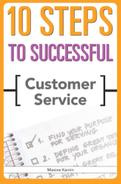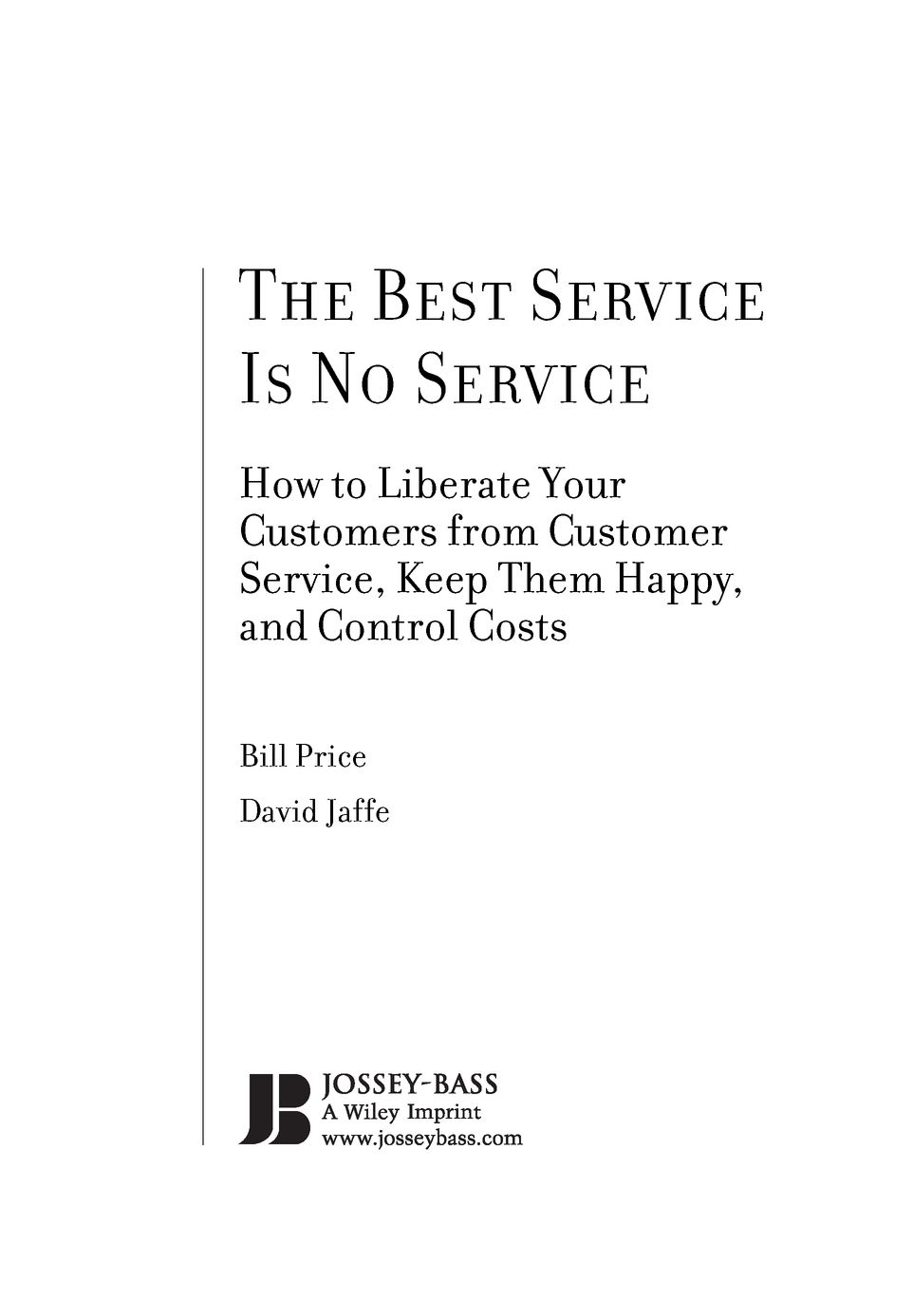Table of Contents
More Praise for
The Best Service Is No Service
It makes a lot of sense to embrace the notion of best service. Not only can companies learn how to listen better to their customers, they can also increase customer satisfaction by figuring out which customer interactions they and their customers want handled by a live person, and which should simply go away or be handled via self-service.
Marc Singer, director, McKinsey & Company
The Best Service Is No Service gives the inside scoop on how to create a no service needed company. Companies large and small need to make sure that their products work right in the first place, and that their self-service functions answer what customers want, while listening to the signals constantly streaming in from their customers.
Jeff Bussgang, general partner, IDG Ventures; co-founder and former president and COO of Upromise
Customer service experiences for customers are inconsistent at best. The key, as authors Price and Jaffe point out, is to eliminate the reason and situations that prompt customers to contact you! Follow their advice and focus your efforts here to make life easier for your customers, your customer service reps, and your bottom line.
Jeanne Bliss, author, chief customer officer, president, CustomerBLISS
David and Bill have brought some insightful but common-sense approaches to the area of customer service. Their book will be an invaluable guide to any company that has a significant volume of service interactions.
Jane S. Hemstritch, non-executive director, Commonwealth Bank of Australia; retired managing director, Accenture, Asia Pacific
The best service ideas and principles on how customer service should work are valuable for any business. They challenge the way that many companies have dealt with customers in the past and show that there is a better way by eliminating defects or mistakes that constantly frustrate customers.
John Egan, vice president, Lenovo Group, Shanghai
Almost every corporate mission statement promises to delight customers and exceed their expectations. Yet most companies continue to frustrate their customers with shoddy service and dash their expectations with broken promises. This book is the cure for all that. Its a blend of smart strategies and best practices for leaders who want to make it easy, quick, even fun, for customers to interact with their companiesand even more, to learn from those interactions to make their companies better. Read this bookyour customers will be delighted that you did!
William C. Taylor, founding editor, Fast Company; coauthor, Mavericks at Work
To Erika, Rachel, Rebecca, and
Patrick, our children
INTRODUCTION: WHY WE WROTE THIS BOOK
Providing awesome customer experiences shouldnt be hard. Companies produce cool new products and services for their customers, meeting their expressed demand and often providing a little bit more than the customers wanted. Customers want to use these products and services to enrich their daily lives or achieve their own personal or business success. Thats why they purchase the product or service: to use or exploit it. They dont buy goods and services in order to contact the customer care or service department.
We call this the wake up in the morning test: Do customers wake up in the morning wanting to contact your company for help, or do they wake up simply wanting to use your goods and services? Do we really need to answer this question?
Unfortunately, a whole industry, customer relationship management (CRM), has grown up claiming that customers want relationships with companies. We agree that customers want and need to work with companies to obtain goods and services that let them achieve their goals. If the products and services work well, as customers have the right to expect, customers will start to feel some sense of loyalty to that company; theyll return for more and recommend the company to others. However, this is not the same as customers wanting to have a relationship with the companys customer service department. The best customers, for most companies, are those who never call or visit but who get what they want from the product or service and then come back for more. In other words, companies might seek a relationship (as CRM espouses), but customers dont want a relationshipthey would rather not know the service arm at all.
When something doesnt make sense or work correctly, the customer calls the company, sends an e-mail message, launches a chat session, sends a text message, writes a letter, or walks into a branch officeand if the service or care processes work, the company responds and clears up the confusion or solves the problem. Good outcome? Not for usthis is a necessary but not sufficient short-term response, or what we will define as Basic Service. We ask, Why did the customer need to make this contact at all? rather than focus on how well the contact was handled.
Although some companies have invested heavily in new processes and technologies for customer service, unfortunately both companies and customers wind up getting into an endless do loop: companies add more customer support resources as they grow the business, and customers become frustrated when they encounter the same broken situations. As the demand for service grows, companies add more resources to handle it or try to find smarter or more efficient ways to do so. Some companies have tried to push customers to self-service, resorting to such tactics as charging for staffed service or expecting customers to wait for responses by phone or e-mail. It is no wonder that customers have become frustrated and annoyed by the poor service they receive. Customers have every right to be frustrated because companies do not seem to be concerned about why customers needed to interact with them in the first place.
Today these customers can express their upset in damning blogs and by exercising their right as consumers to shop elsewhere. Many authors have described the rising tides of customer frustration. A 2006 survey found that poor customer service caused nearly half of U.S. consumers to switch at least one service provider over the year. That is not good enough in anyones book.
Fortunately, there is a better way, one that we feel compelled to describe in this book as a manifesto:
Stop coping with customer demand for service, which simply increases customers frustration; instead, challenge customer demand for service so that, ideally, everything works perfectly, eliminating defects and confusion so that there is no need at all for customers, or even prospective customers, to contact the company for information or for help.
While challenging demand for service and eliminating what we call dumb contacts, companies will need to put into place self-service that works and to become more proactive to prevent contacts from hitting their customer service centers. This is what we call the Best Service Is No Service. To achieve Best Service will take a sea change in behaviors, processes, and metrics, but the returns are well worth it: more satisfied customers, reduced operating costs leading to higher profits, and happier employees.












